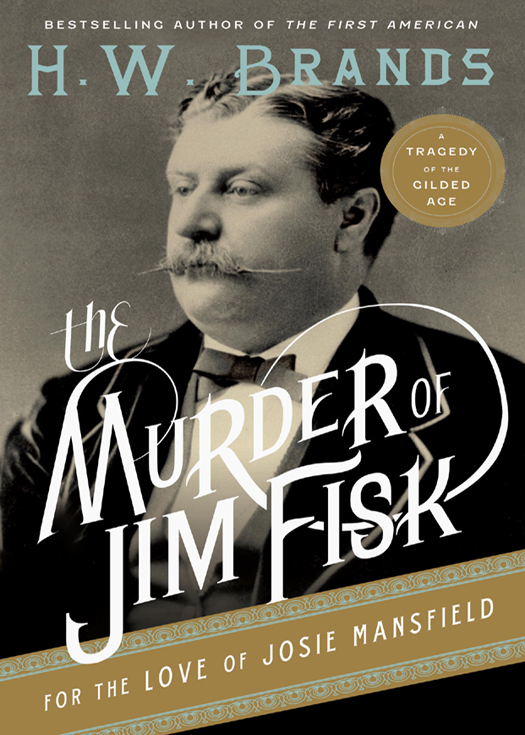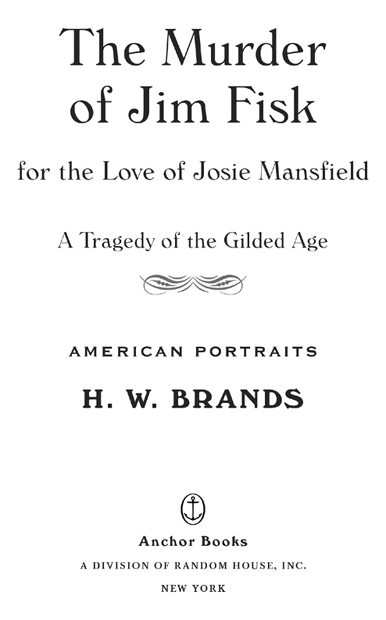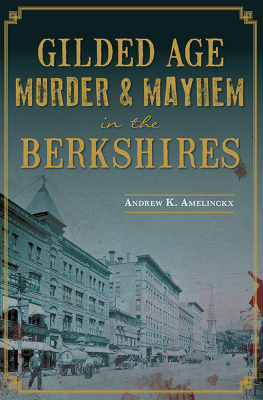H.W. Brands - The Murder of Jim Fisk for the Love of Josie Mansfield: A Tragedy of the Gilded Age
Here you can read online H.W. Brands - The Murder of Jim Fisk for the Love of Josie Mansfield: A Tragedy of the Gilded Age full text of the book (entire story) in english for free. Download pdf and epub, get meaning, cover and reviews about this ebook. year: 2011, publisher: Anchor, genre: Detective and thriller. Description of the work, (preface) as well as reviews are available. Best literature library LitArk.com created for fans of good reading and offers a wide selection of genres:
Romance novel
Science fiction
Adventure
Detective
Science
History
Home and family
Prose
Art
Politics
Computer
Non-fiction
Religion
Business
Children
Humor
Choose a favorite category and find really read worthwhile books. Enjoy immersion in the world of imagination, feel the emotions of the characters or learn something new for yourself, make an fascinating discovery.

- Book:The Murder of Jim Fisk for the Love of Josie Mansfield: A Tragedy of the Gilded Age
- Author:
- Publisher:Anchor
- Genre:
- Year:2011
- Rating:5 / 5
- Favourites:Add to favourites
- Your mark:
- 100
- 1
- 2
- 3
- 4
- 5
The Murder of Jim Fisk for the Love of Josie Mansfield: A Tragedy of the Gilded Age: summary, description and annotation
We offer to read an annotation, description, summary or preface (depends on what the author of the book "The Murder of Jim Fisk for the Love of Josie Mansfield: A Tragedy of the Gilded Age" wrote himself). If you haven't found the necessary information about the book — write in the comments, we will try to find it.
The Murder of Jim Fisk for the Love of Josie Mansfield: A Tragedy of the Gilded Age — read online for free the complete book (whole text) full work
Below is the text of the book, divided by pages. System saving the place of the last page read, allows you to conveniently read the book "The Murder of Jim Fisk for the Love of Josie Mansfield: A Tragedy of the Gilded Age" online for free, without having to search again every time where you left off. Put a bookmark, and you can go to the page where you finished reading at any time.
Font size:
Interval:
Bookmark:

AMERICAN PORTRAITS
The big stories of history unfold over decades and touch millions of lives; telling them can require books of several hundred pages. But history has other stories, smaller tales that center on individual men and women at particular moments that can peculiarly illuminate historys grand sweep. These smaller stories are the subjects of American Portraits: tightly written, vividly rendered accounts of lost or forgotten lives and crucial historical moments.

H. W. BRANDS
The Murder of Jim Fisk
for the Love of Josie Mansfield
H. W. Brands is the Dickson Allen Anderson Centennial Professor of History at the University of Texas at Austin. He was a finalist for the Pulitzer Prize in biography for The First American: The Life and Times of Benjamin Franklin and for Traitor to His Class: The Privileged Life and Radical Presidency of Franklin Delano Roosevelt.
www.hwbrands.com
The Reckless Decade
T.R.
The First American
The Age of Gold
Lone Star Nation
Andrew Jackson
Traitor to His Class
American Colossus

AN ANCHOR BOOKS ORIGINAL, JUNE 2011
Copyright 2011 by H. W. Brands
All rights reserved. Published in the United States by
Anchor Books, a division of Random House, Inc., New York,
and in Canada by Random House of Canada Limited, Toronto.
Anchor Books and colophon are registered trademarks
of Random House, Inc.
Photo section credits: Picture History: .
Library of Congress Cataloging-in-Publication Data
Brands, H. W.
The murder of Jim Fisk for the love of Josie Mansfield : a tragedy
of the Gilded Age / H. W. Brands.
p. cm.(American portraits)
eISBN: 978-0-307-74327-5
1. Fisk, James, 18351872Assassination.
2. Fisk, James, 18351872Relations with women.
3. Capitalists and financiersUnited StatesBiography.
4. MurderNew York (State)New YorkHistory19th century.
5. Mansfield, Josie. 6. ShowgirlsUnited StatesBiography.
7. New York (N.Y.)Biography. 8. New York (N.Y.)Social life and
customs19th century. I. Title.
CT275.F565B73 2011
974.7103092dc22
2010051174
Author photograph Marsha Miller
www.anchorbooks.com
Cover: Jim Fisk Bettmann/Corbis: Josie Mansfield, photograph by William S. Warren Picture History
Cover design by W. Staehle
v3.1

A gray blanket cloaks the trees of Montparnasse on a late autumn morning. Smoke from the coal fires that heat the homes and shops along the narrow streets swirls upward to join the fog that congeals intermittently into drizzle. This part of Paris hides the signs of the Great Depression better than the blighted industrial districts, but the tattered storefronts, the shabby dress of men with nowhere to go, and the age of the few cars that ply the streets betray a community struggling to keep its soul together.
An old, oddly configured vehicle lumbers slowly along the cobbles. The dispirited pedestrians pay it no mind. Nor do they heed the two women and one man who walk behind it. The women appear to be locals; the shawls around their shoulders and the scarves on their heads could have been taken from the woman selling apples on one of the corners they pass or from the grandmother dividing a thin baguette among her four little ones. (Or could she be their mother? Hard times play evil tricks on youth and beauty.)
The man must be a foreigner. He dresses like an Englishman, one whom the Depression seems to have spared. His heavy wool coat and felt hat shield him from the damp; the coats collar and the hats brim hide his face from those around him. He might be an American; he walks more assertively than the average Englishman. He probably walked still more assertively when he was younger, although how many years have passed since that sprightly era is impossible to say.
The two women speak quietly to each other. Neither addresses the man, nor he them. The vehiclewhether it is a car or a truck is as much a puzzle as most else about this small processionslows almost to a stop, then turns onto the leaf-strewn lane of the cemetery that these days forms a principal raison dtre of the neighborhood. It moves tentatively along the track, picking its way among the gravestones and mausoleums, beneath the connecting branches of trees left over from when the farm on this site began accepting plantings that didnt sprout, not in this existence. The driver finally locates what he has been looking for, and he stops beside a fresh pile of dirt that is gradually turning dark as the drizzle soaks in. Two men shrouded in long coats suddenly but silently appear, as if from the earth itself. They stand at the rear of the vehicle as the driver lowers the gate. They grasp handles on the sides of the bare wooden box the vehicle contains, and with a nonchalance just shy of disrespect they hoist it out and set it on the ground between the pile of dirt and the hole from which the dirt has come.
They step aside, wordlessly letting the three mourners know that this is their last chance to commune with the deceased. One of the women produces, from a cloth bag, a small cluster of chrysanthemums and places it on the coffin. The man takes a rose from inside his coat and, with quiet tenderness, lays it beside the other flowers.
The three step back and gaze down at the wooden box. The drizzle turns to rain. The gravediggers slip short loops of rope inside the handles and lower the coffin into the grave. They pull up the ropes and begin shoveling the dirt back into its hole.
The hearse drives away, at a faster pace than before. The women walk off together. The man lingers. He looks at the grave, then at the city in the distance, then back at the grave. Finally he too departs.

Another day, another decade, another funeral. And such a funeral. Lifelong New Yorkers cannot remember larger crowds, even to mark the Union victory in the Civil War. Many of those present today attended the victory celebration, but it is the nature of life in the great city, and the strength of the citys appeal to outsiders, that a large part of the population has turned over in the seven years since the Confederate surrender at Appomattox. Today the newcomers crane to see what the fuss is about.
The funeral begins at the Grand Opera House on Twenty-third Street, where the body has lain for viewing. No one thinks the choice of venue oddor at least none thinks it odder than that the Opera House is also home to one of Americas great railroads, the Erie, of which the deceased was a director and to which he, as owner of the Opera House, rented office space. The lavish interior of the housethe sweeping grand staircase, the twenty-foot mahogany doors embellished with the company initials E. R., the bronze horses pawing the air furiously with their forehooves, the two-story mirror with the bust of Shakespeare on top, the sumptuous wall hangings, the carved and gilt columns, the cherubs disporting about the ceiling, the fountains spewing water into the airhas been rendered somewhat more somber for the sad occasion by the addition of black muslin tied up with black and white satin rosettes, to cover the cherubs and hide the gilt.
Font size:
Interval:
Bookmark:
Similar books «The Murder of Jim Fisk for the Love of Josie Mansfield: A Tragedy of the Gilded Age»
Look at similar books to The Murder of Jim Fisk for the Love of Josie Mansfield: A Tragedy of the Gilded Age. We have selected literature similar in name and meaning in the hope of providing readers with more options to find new, interesting, not yet read works.
Discussion, reviews of the book The Murder of Jim Fisk for the Love of Josie Mansfield: A Tragedy of the Gilded Age and just readers' own opinions. Leave your comments, write what you think about the work, its meaning or the main characters. Specify what exactly you liked and what you didn't like, and why you think so.






